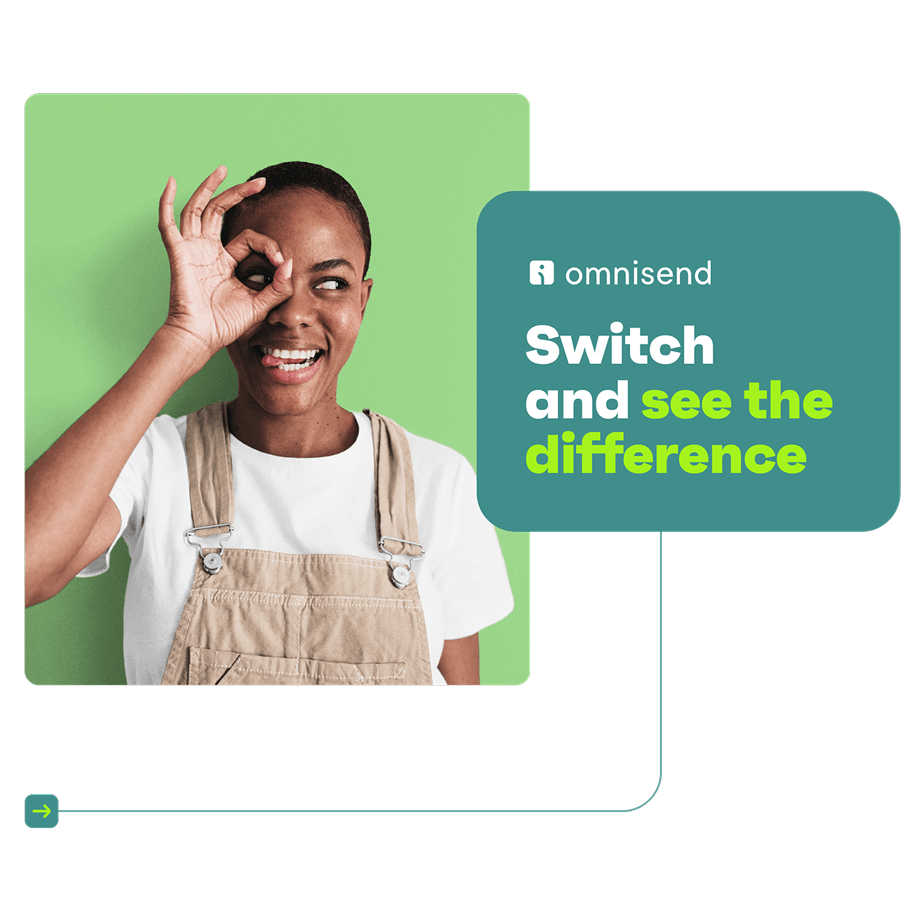
Drive sales on autopilot with ecommerce-focused features
See FeaturesThe debate of Shopify Email vs. Klaviyo is common among ecommerce merchants, but what they don’t know is that both these platforms are built to handle email marketing differently.
Choosing between Shopify Email and Klaviyo involves considering your budget vs. required features vs. growth.
Shopify Email is budget-friendly and includes 10,000 free emails/month. However, it has limited automation and segmentation for basic email needs.
Meanwhile, Klaviyo offers advanced automation, deep customer segmentation, and detailed analytics. The tradeoff is higher pricing, which can strain businesses with smaller budgets.
So, which should you choose between Klaviyo vs. Shopify Email? We’ll break down features, costs, and real-world examples to help you make the best decision for your store in 2025.
Quick sign up | No credit card required
Shopify Email vs. Klaviyo: Which fits you best?
For Shopify merchants, choosing the right email platform involves balancing cost and useful functionalities. When deciding between Shopify Email vs. Klaviyo, it often comes down to what stage of growth your business is in.
Shopify Email offers ease and affordability for beginners or small businesses that want to launch email campaigns. In contrast, Klaviyo is a more advanced email marketing platform that delivers data-driven tools for merchants ready to scale.
Here’s a side-by-side comparison to help you decide between these two tools:
| Feature | Shopify Email | Klaviyo |
|---|---|---|
| Ease of use | Very simple and beginner-friendly | Steeper learning curve |
| Advanced automation | Basic only | Comprehensive multi-trigger flows |
| Advanced segmentation | Limited | Behavior + predictive data |
| A/B testing | ❌ | Built-in testing |
| SMS marketing | ❌ | ✅ |
| Web push notifications | ❌ | ✅ |
| Pre-built templates | ✅ | ✅ |
| Reporting and analytics | Basic | Detailed dashboards |
| Free plan generosity | 10,000 email sends/month | Free for 250 active profiles and 500 emails/month |
| Pricing model | Pay-as-you-go | Subscription by contacts |
| Native Shopify integration | Direct, built-in | Strong but requires integrations |
If you’re just starting or want low-cost, straightforward campaigns, Shopify Email is the smarter pick. It’s budget-friendly, easy to use, and built directly into Shopify. If you’re scaling fast and need advanced marketing features, Klaviyo email marketing for Shopify is the clear winner despite its higher cost.
Features overview
Shopify Email has a feature set for ease of use with one-click automations, a simple template builder, and basic segmentation. Klaviyo offers more features for advanced marketing, giving you granular control over marketing communications.
Let’s take a look at how Shopify Email and Klaviyo stack up against each other in terms of features. This should help you decide which platform aligns best with your business needs.
Shopify Email
Your store dashboard includes Shopify Email, which includes built-in templates that showcase your branding, products, and pricing details. A simple drag-and-drop editor helps customize pre-built templates for various purposes.

AI-powered features handle subject line generation and send time optimization. You can create campaigns, segment customers, and track results without leaving your Shopify admin. Shopify keeps your product data, customer lists, and analytics synchronized.
The triggers and rules for automated messages are less extensive than Klaviyo’s offering but cover the most common ecommerce scenarios, including welcome emails, win-back campaigns, and promotional flows that connect to your store data.
Shopify’s analytics dashboard provides click-through rates, open rates, products added to cart, average order value, and purchase metrics to help you track performance.
Klaviyo
Klaviyo creates complex automation flows that combine email, SMS, and mobile push notifications into cohesive customer journeys. Its email templates are much more comprehensive than those of Shopify Email, and the drag-and-drop builder offers more customization features.
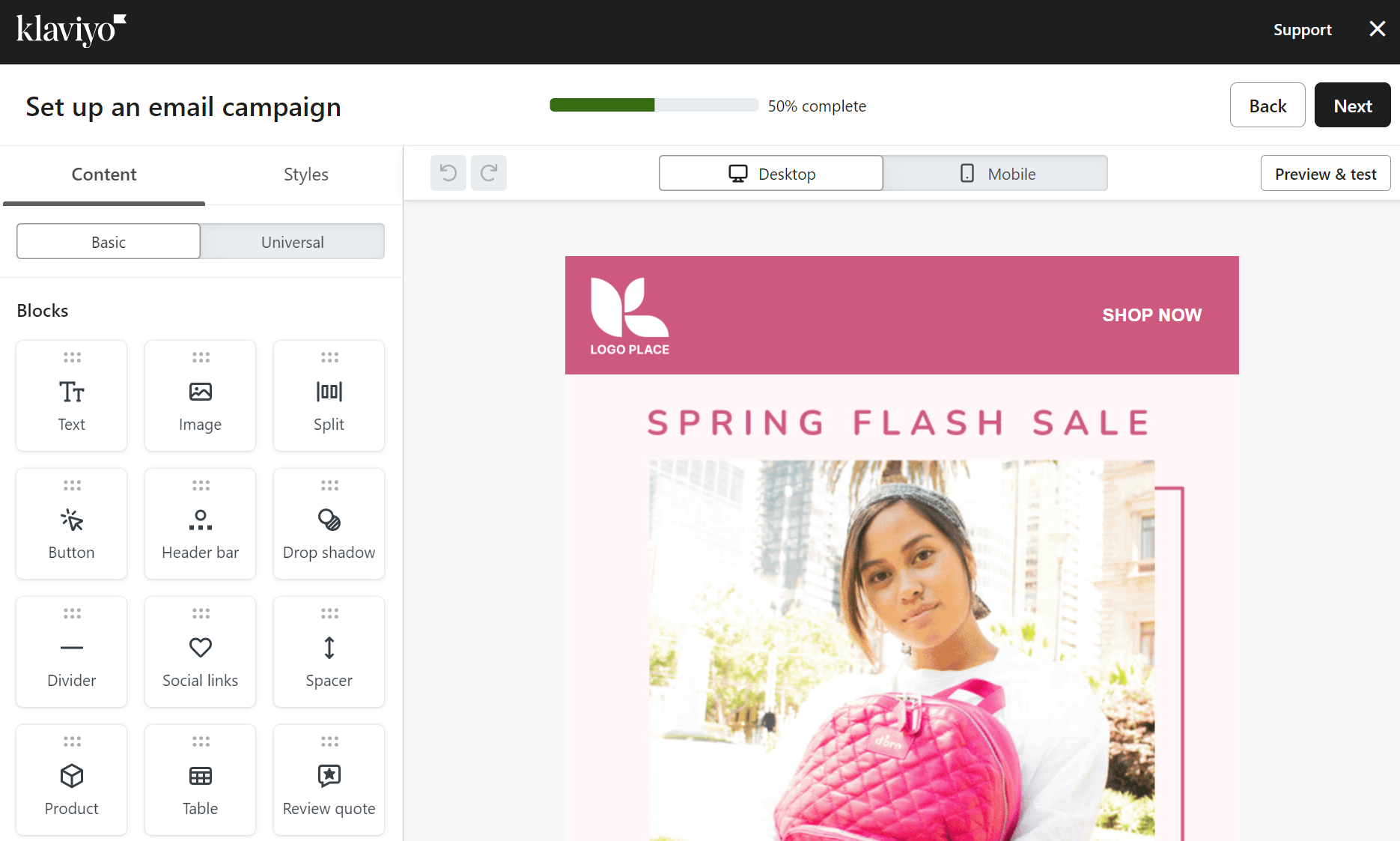
Its more extensive email segmentation filters can group customers based on behavior, predictions, and data from over 350 integrated apps. For instance, if you have a TikTok account, you can create a list in Klaviyo and pull in your TikTok Audiences.
The automations in Klaviyo surpass those in Shopify Email, letting you trigger personalized messages for cart and browse abandonment, anniversaries, price drops, back-in-stock requests, low inventory alerts, and more.
In-depth analytics, including revenue tracking, predictive insights, and competitive benchmarks, help you refine your marketing approach.
Comparison verdict
Advanced features and multi-channel capabilities distinguish Klaviyo, while Shopify Email delivers everything most new stores need in one place. The choice between Shopify Email vs. Klaviyo would depend on your business stage and marketing needs. Your business should consider Klaviyo when you’re ready to invest in sophisticated marketing automation.
Ease of use
You’ll master Shopify Email long before Klaviyo, but that’s not to say Klaviyo is a difficult email marketing tool — it’s very well thought out and makes complex features simple to understand.
Shopify Email
Shopify Email is significantly easier to use than Klaviyo because it’s part of your Shopify dashboard, and you just can’t beat that familiarity.
The Marketing dashboard in your Shopify account lists installed marketing app activities and recommends new ones. Select Apps in the sidebar and Email when the dropdown box triggers to navigate to Shopify Email.
The dashboard looks like this:
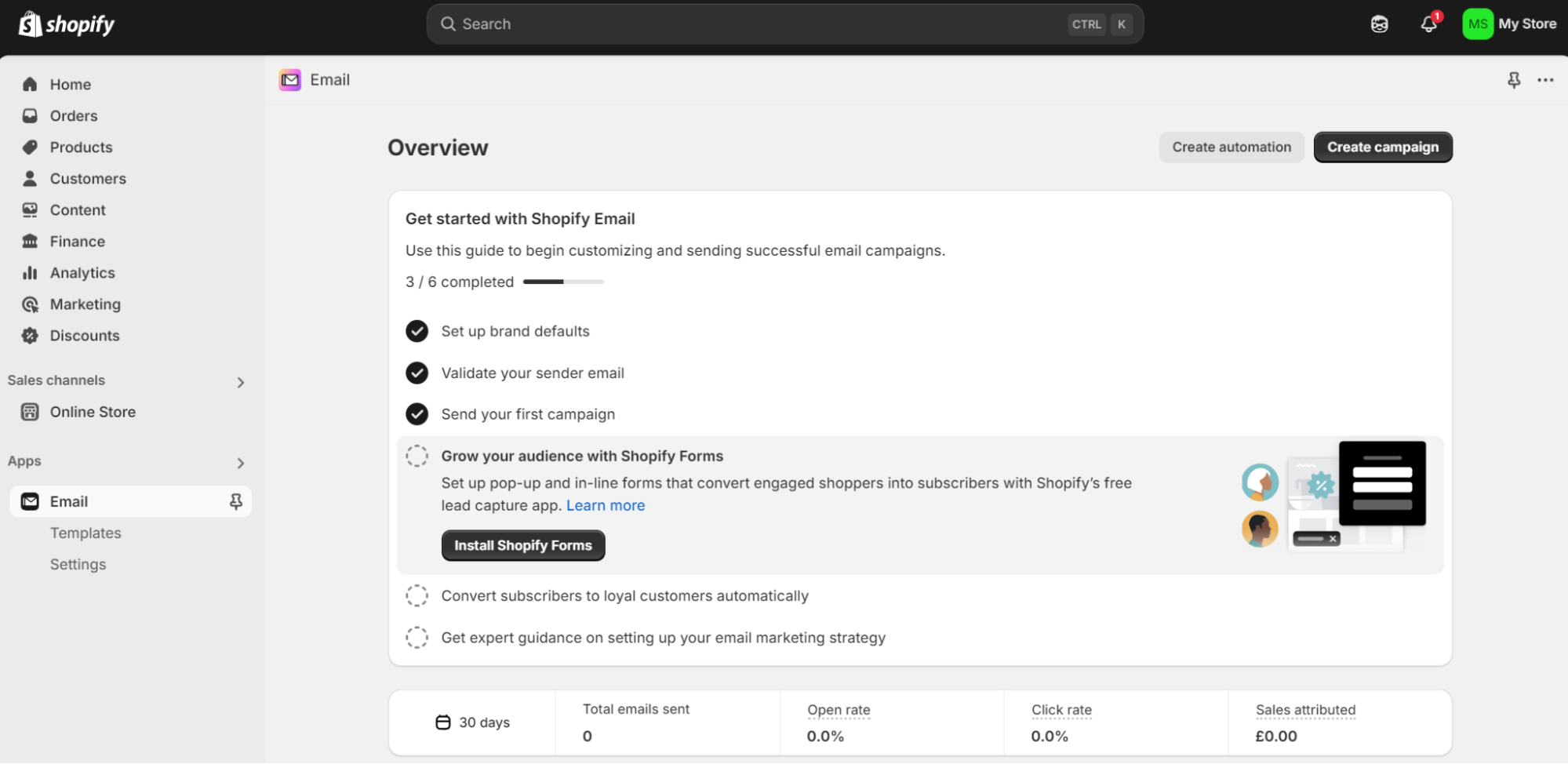
As you can see, it has a clean, intuitive interface. It offers quick options like Create automation or Create campaign, guiding you step by step through the email creation process.
For those who don’t want to start from scratch, Shopify Email provides pre-built templates designed for common ecommerce use cases.
Another feature that adds to its simplicity is the unified search bar. Shopify Email’s tools and features are just a search away. You can easily locate templates, past campaigns, or performance insights.
As you explore, Shopify also suggests complementary apps like Shopify Forms, which integrates directly with Shopify Email to help you capture leads and grow your subscriber list.
Klaviyo
Klaviyo’s dashboard is very easy to navigate using the sidebar and multiple actionable sections for picking up where you left off, viewing your performance dashboard, creating flows, and sending campaigns:
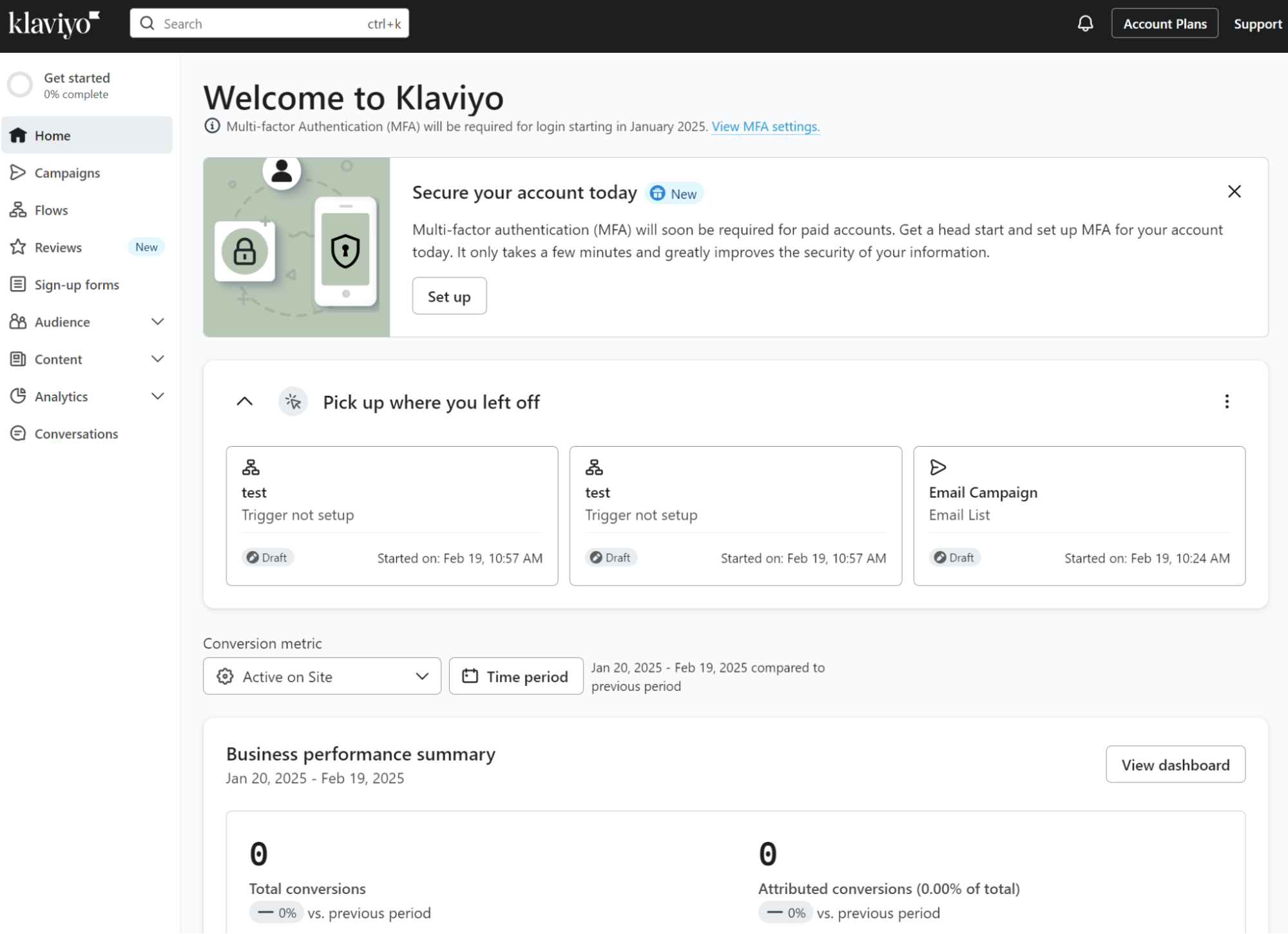
Every feature has a guided setup process that makes things simple. For instance, heading to Campaigns > Create campaign loads quick options:
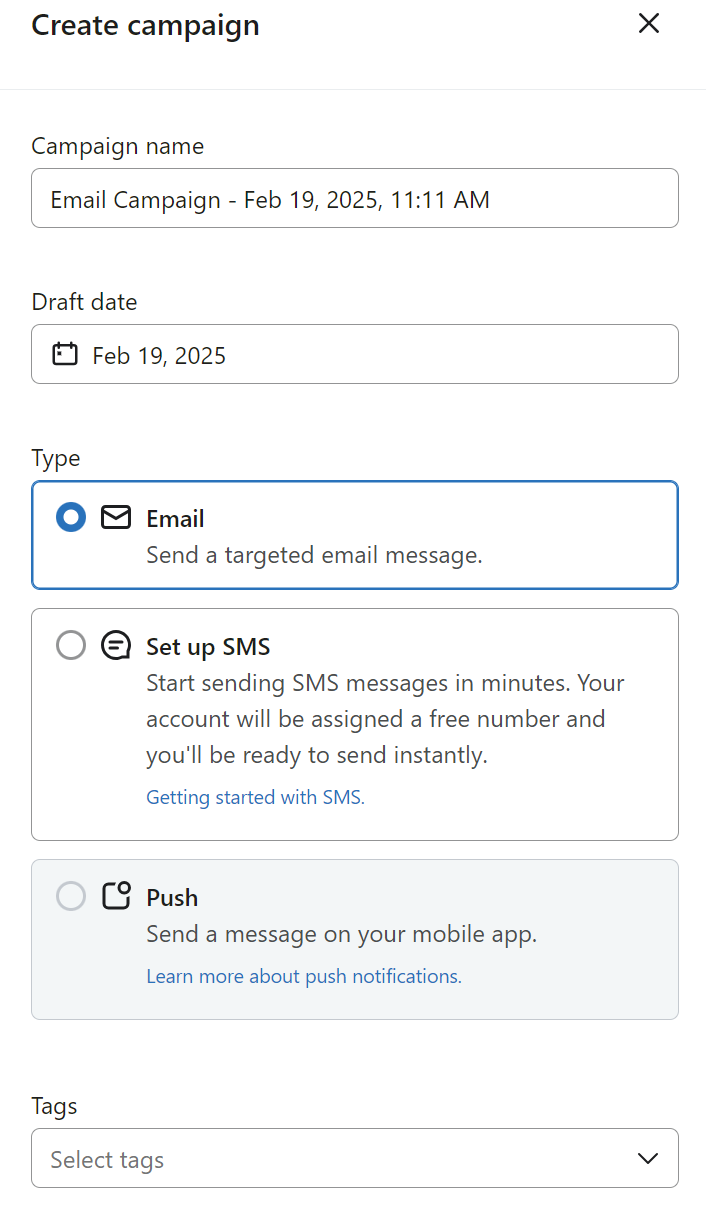
This also applies when creating flows — automated sequences based on customer behavior, such as welcome series, abandoned cart reminders, or post-purchase follow-ups.
Klaviyo provides pre-built flow templates with best-practice recommendations. Such guidance helps beginners get started while also giving advanced users full control to customize every step.
However, because Klaviyo has so many different triggers, filters, flows, and segment options, it does take considerable time to understand all its capabilities.
Comparison verdict
The difference in ease of use between Shopify Email vs. Klaviyo is clear. Shopify Email wins with its familiar dashboard and straightforward features. While Klaviyo offers guided setups, its extensive capabilities require more time to master fully.
Email builders and customization
Klaviyo and Shopify Email have template libraries for newsletters, promotions, announcements, and shoppable emails. You can also build from scratch.
Shopify Email
Shopify Email’s template library can’t match Klaviyo in terms of numbers or design variety. However, its templates do look professional without customization, and if you want to make them more cohesive with your branding, the drag-and-drop editor makes it easy:
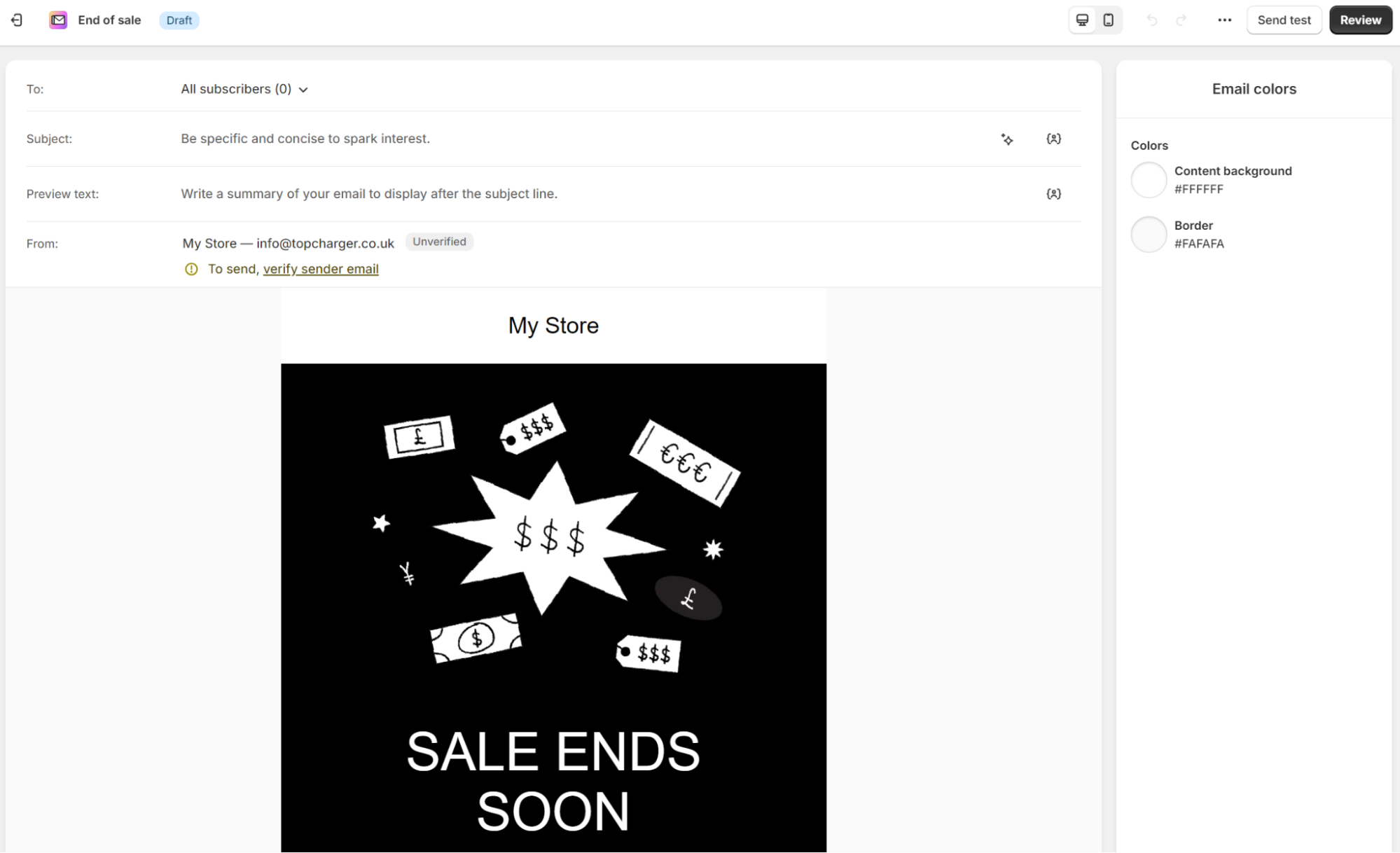
With the + Add section button, you can add sections to your templates, including Text, Button, Image, Video, Product, Discount, and Express checkout. The Product item syncs to your catalog, and the Express checkout creates shoppable emails.
Shopify Email and Klaviyo let you preview desktop and mobile designs and send test emails within their email builders. Shopify Email has a Review stage that catches errors, such as default content, before approval.
Klaviyo
Klaviyo’s email builder also uses a drag-and-drop interface, but it’s a more intuitive and polished tool. For instance, Klaviyo has a sidebar with available sections, while in Shopify Email, you have to click the + Add section to load them.
Here’s Klaviyo:
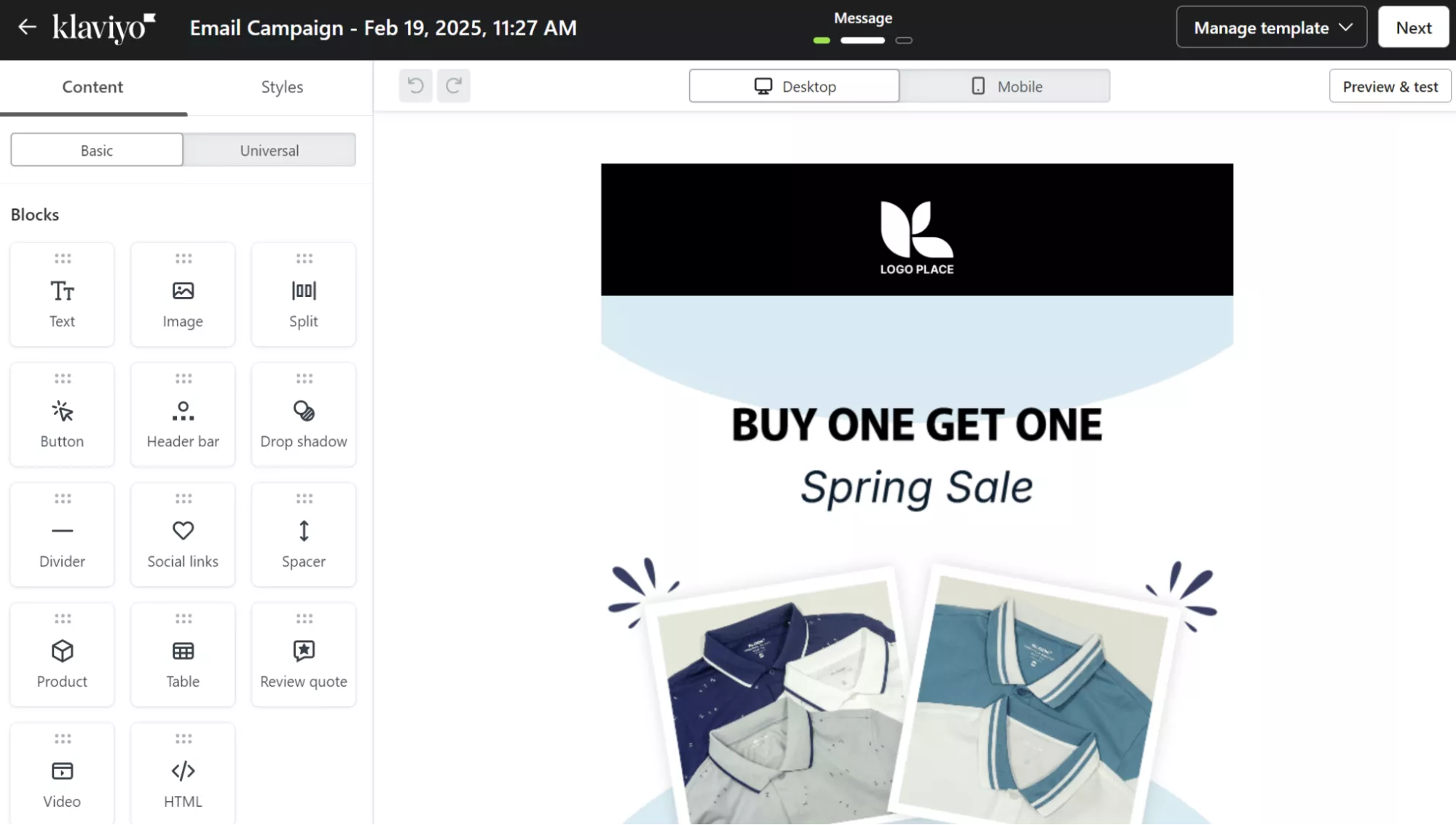
Now, here’s Shopify:
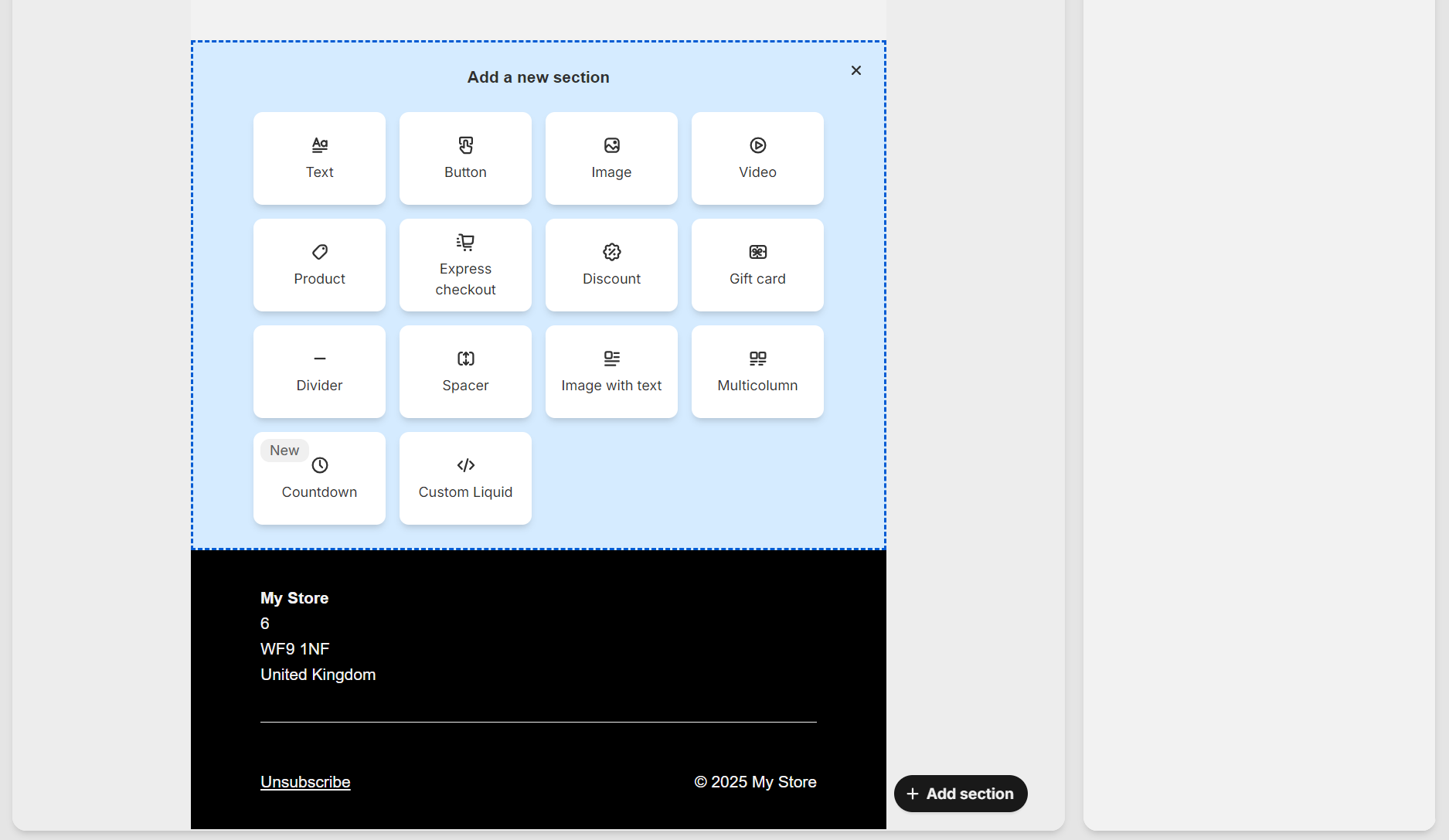
See how the sections are always available in Klaviyo? It’s a more straightforward way to build emails. Also, the Styles toggle is part of the same sidebar in Klaviyo, giving you all the tools in one place.
Klaviyo’s template library is another bonus point, offering far more variety and better-looking designs with animated buttons and professional layouts. Shopify Email’s templates are basic in comparison (although possibly no less effective for driving revenue).
Comparison verdict
Klaviyo’s email builder offers a more polished design experience with a superior template library and intuitive interface. Shopify Email’s simpler builder and templates still do the job for basic email marketing.
Pro tip: Try Omnisend’s subject line tester to see how your subject line and preview text will display on different devices.
Automation and workflows
Shopify Email and Klaviyo handle behavioral and transactional automations and scheduling to help you build a complete email marketing strategy. Klaviyo offers greater control and a better workflow builder, but it isn’t as easy to master.
Shopify Email
Shopify Email has over 15 automation templates that you can quickly configure, such as “welcome new customers with a discount series,” “thank customers after they purchase,” and “upsell customers after their first purchase.”
It’s crucial to note that to use automations, you need the Shopify Flow app, which is free to install. You can then access all pre-built automations in the dashboard:
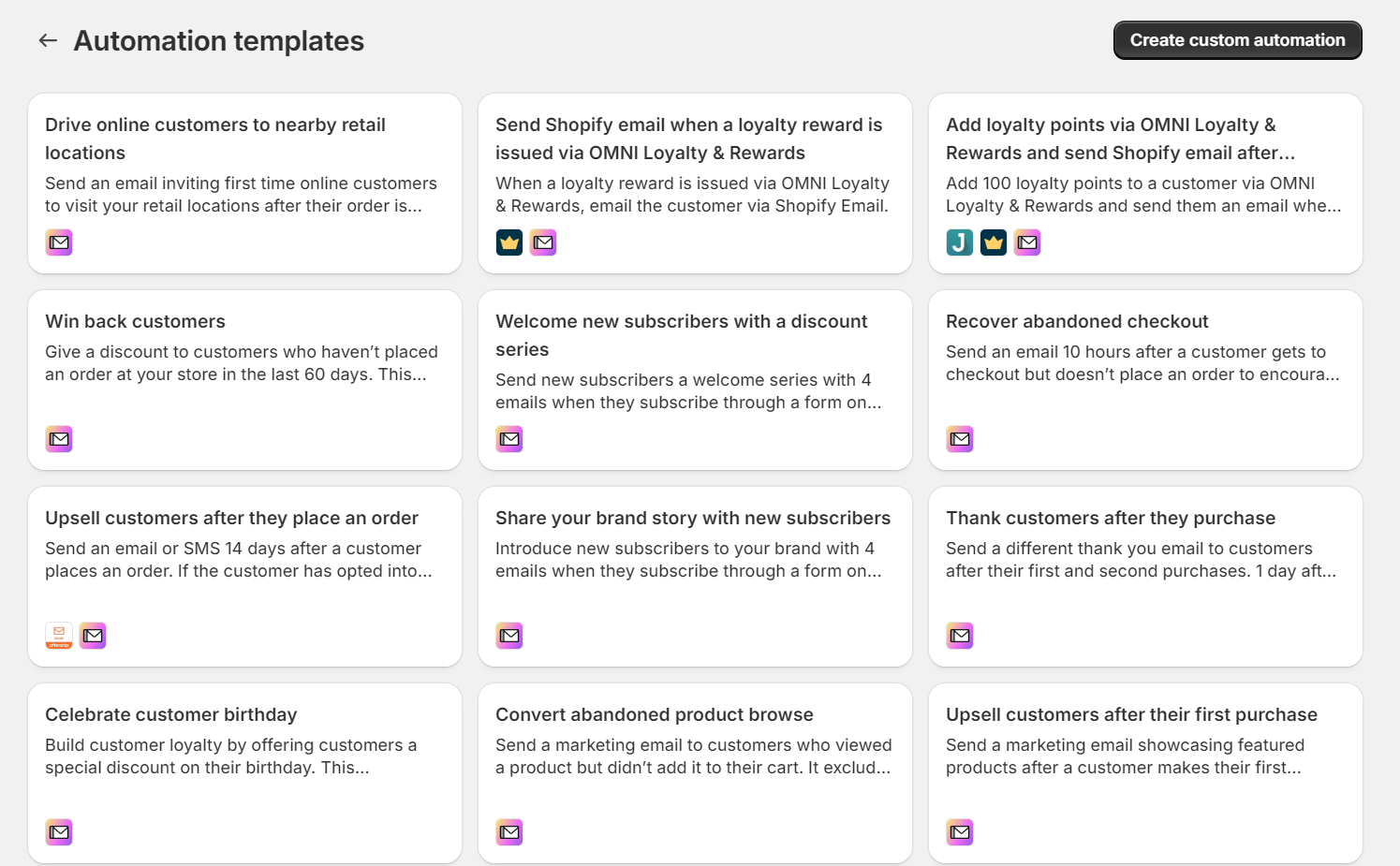
Selecting one of these automations takes you to the visual Automations editor, where you can change its display, timing, and trigger rules, plus assign an email template:
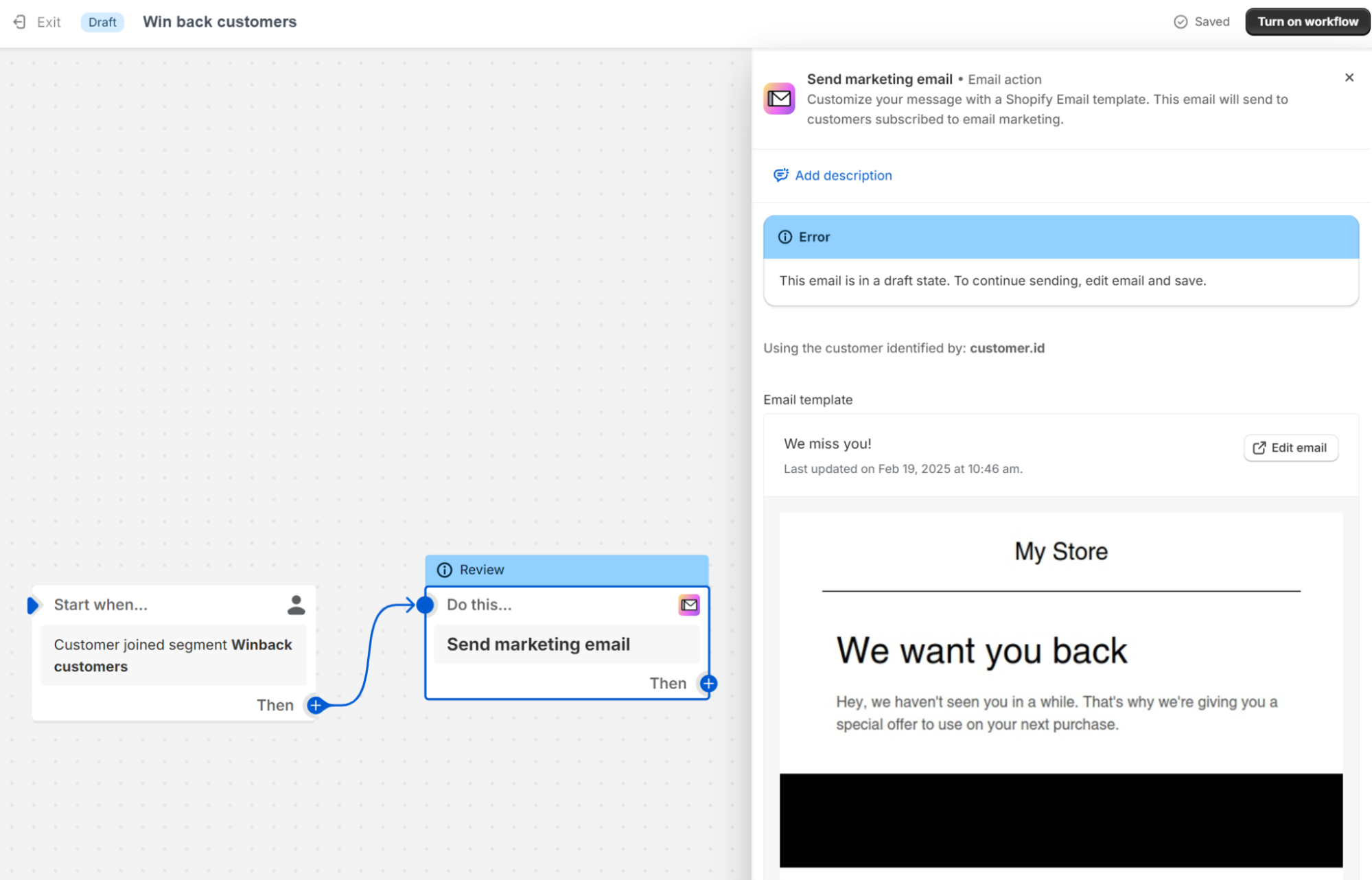
The automation builder is easy to use, with + triggers to add new modules. It lacks the customizable variables Klaviyo offers, but covers the basics perfectly well, with pre-built templates that take only a few minutes to configure.
Klaviyo
Klaviyo calls its automations Flows, with a more extensive library of pre-built templates covering nurturing, reminders, and marketing goals such as preventing lost sales:
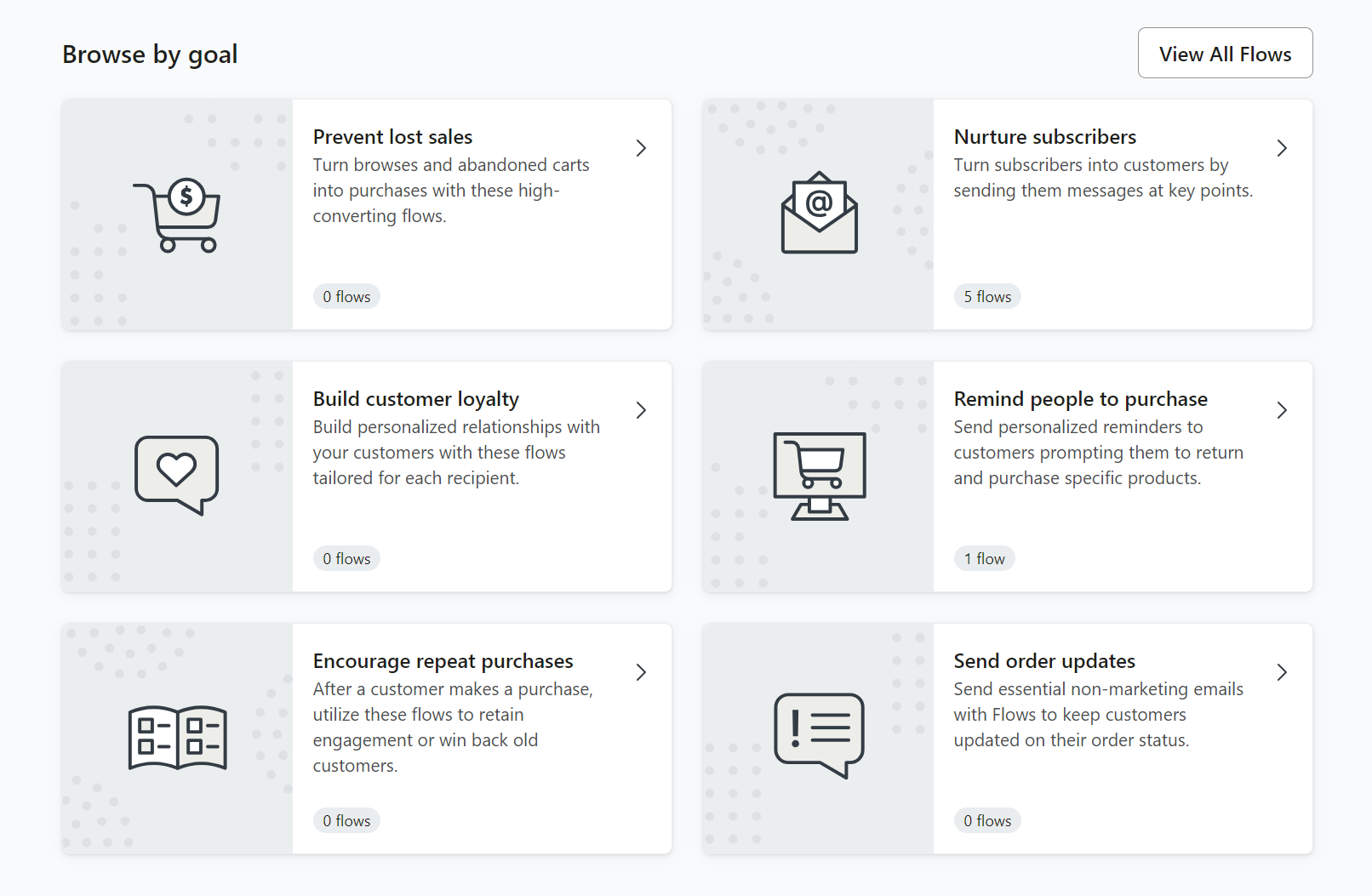
These marketing goal automations cover every stage of your customer journey. You can also search for a Flow or build one from scratch.
Klaviyo’s Flow builder has a clear layout with a sidebar that recommends triggers and filters based on popularity and your metrics:

Building automations in Klaviyo is intuitive and provides a sense of complete coverage, as it gives you every conceivable targeting approach.
Comparison verdict
When weighing the automation features of Shopify Email vs. Klaviyo, the decision comes down to whether you value ease of use and speed or advanced customization and depth.
Klaviyo offers more advanced automation capabilities with detailed targeting options, while Shopify Email’s automation templates cover essential needs through a simpler, faster setup process. Klaviyo’s learning curve is steeper, but you get greater functionality in return.
Audience segmentation and targeting
Klaviyo has superior segmentation and targeting features to Shopify Email, such as segmenting on channel consent, customer lifetime value (CLV), and form results. Shopify Email does cover segmentation basics, too, such as customers who made multiple purchases.
Shopify Email
You can build custom customer segments in Shopify by combining filter names, operators, and values in the editor on the Customers or Segments page.
Shopify’s segmentation connects seamlessly with Shopify Email since both are native features. You can target customers from your dashboard based on purchase history, marketing preferences, locations, and custom tags.
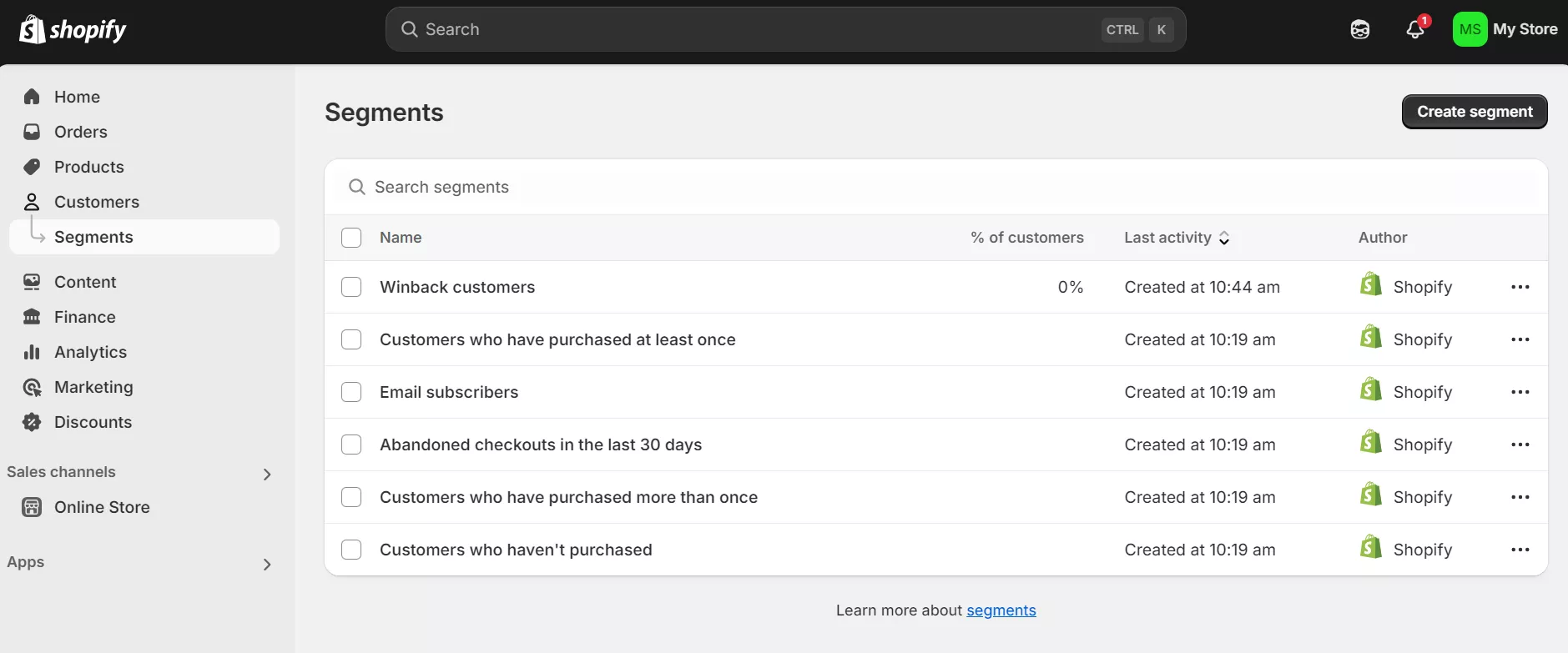
When creating a campaign, select any existing segment or build a new one using Shopify’s customer data.
Creating segments in Shopify automatically updates them as customers meet your criteria. For example, a segment of “subscribed customers who spent over $100” will grow as new customers hit that threshold.
Since Shopify Email uses this same segmentation system, your campaigns always reach the right audience without manual updates.
Every customer who matches your segment criteria feeds through, though only those who have subscribed to marketing will receive your emails.
Klaviyo
You can create custom segments in Klaviyo by navigating to Audience > Lists & Segments, clicking Create New, and using the segment builder to add conditions that define your audience.
Klaviyo’s segmentation tools help you target specific customer groups based on their actions and behaviors. The Lists & Segments dashboard lists all current segments and lists:
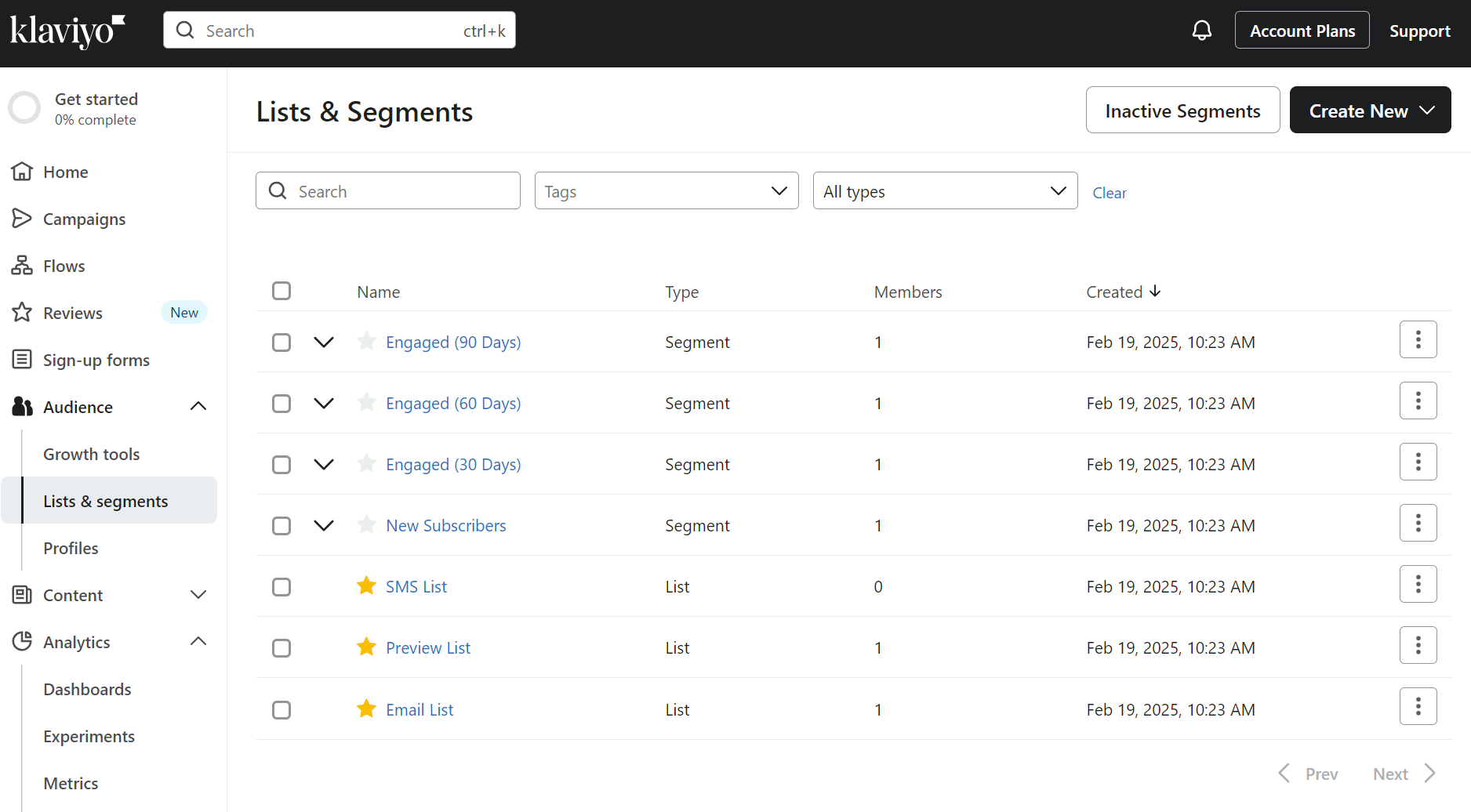
Selecting Create New lets you build segments using purchase history, email engagement, website behavior, or predicted lifetime value.
You can combine multiple conditions with AND/OR logic to reach precise audiences, such as customers who bought specific products but haven’t engaged recently. Your segments sync in real-time, automatically adding new customers who match your criteria.
There’s also an AI-powered segment builder that can generate targeting rules from natural language descriptions, helping you quickly create complex customer groups.
Comparison verdict
Klaviyo and Shopify Email let you create segments in a few steps, but the difference lies in the depth. Shopify Email covers the basics — great for grouping customers by simple behaviors like purchase history or location. However, Klaviyo’s segment builder is more intuitive and condition-rich thanks to AND/OR logic.
Analytics and reporting
Shopify combines your store analytics with email metrics, providing an ecommerce-focused dashboard with real-time data. Klaviyo offers more features, such as the ability to drill down by metric type and assign filters.
Shopify Email
Shopify Email analytics metrics include emails sent, open rates, click rates, sessions generated, delivery rates, bounce rates, and spam complaints.
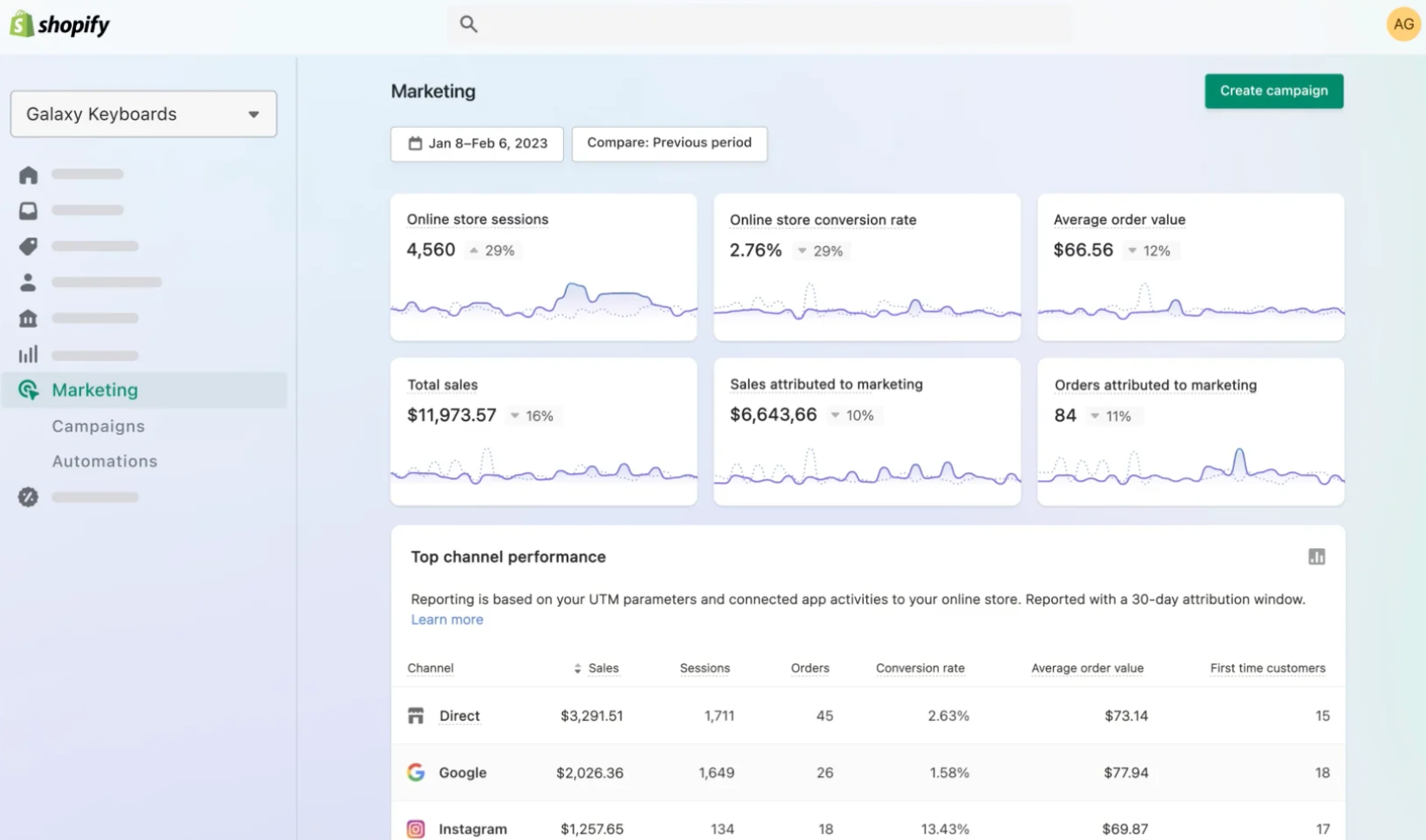
The Orders section uses the last non-direct click attribution to track total orders, total sales, and average order value directly linked to your email campaign.
Its email conversion funnel breaks down recipient interactions, including email opens, unique store visitors, items added to the cart, and final purchases.
UTM tracking enables integration with third-party analytics like Google Analytics, allowing you to customize tracking parameters and compare cross-platform conversion data.
Klaviyo
Klaviyo’s reporting capabilities offer comprehensive insights into your marketing performance across email and SMS. Its Analytics overview provides snapshot insights, but its Metrics tab is the most useful feature for pinpointing data:
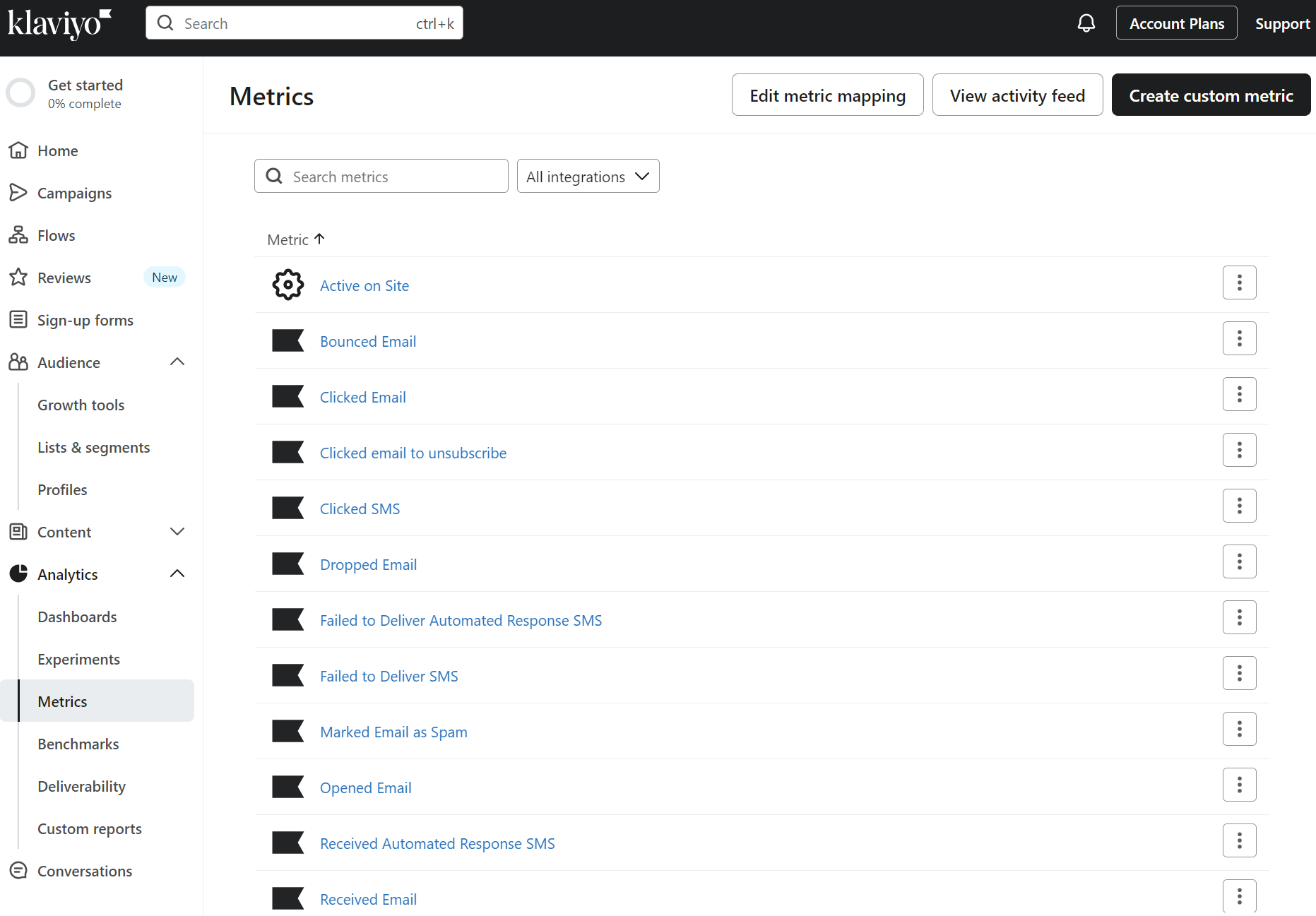
The analytics dashboard provides detailed visualizations of key metrics, such as campaign performance, flow effectiveness, email deliverability, and conversion rates.
You can track revenue attribution and engagement trends, benchmark performance against similar businesses, and monitor individual campaign and flow analytics, including recipient behavior, opens, clicks, and conversions.
With customizable date ranges and the ability to compare different marketing channels, Klaviyo allows you to make data-driven decisions and optimize your marketing strategies effectively.
Comparison verdict
Both platforms track essential metrics like opens, clicks, and revenue, but Klaviyo provides deeper analytics with cross-channel insights, benchmarking, and predictive data. Shopify Email’s reporting covers the basics while integrating naturally with your store’s data.
Integration with ecommerce platforms
Shopify Email lives within your Shopify ecosystem, while Klaviyo connects your marketing data across hundreds of platforms and social channels.
Shopify Email
Shopify Email is a native Shopify feature enabled by the Shopify Email app, so it doesn’t integrate with other ecommerce platforms.
You can import contact lists and data from social media to create new lists, but the Shopify Email app doesn’t handle them.
The Shopify platform, however, does integrate with other apps, which can complement your email marketing strategy. For instance, you can sync Shopify Email with AliDrop for dropshipping and Printify for print-on-demand.
Klaviyo
Klaviyo has over 350 integrations and support for Shopify, WooCommerce, Squarespace, Wix, OpenCart, BigCommerce, PrestaShop, and many more platforms.
The crucial difference is that it integrates Facebook, TikTok, Pinterest, Canva, Shogun, ShipBob, Reviews.io, and many more apps to share data. You can make these apps part of your email workflows to connect all your marketing efforts.
Comparison verdict
While Shopify Email works exclusively with Shopify stores, Klaviyo connects with over 350 platforms and apps to create a unified marketing ecosystem, making it the winner here.
Customer support and resources
Shopify Email
Shopify provides 24/7 chat and email support across all its paid plans, although there isn’t dedicated support for Shopify Email.
The Advanced plan provides 24/7 chat support, and the expensive Shopify Plus plan provides priority phone or live chat support.
Shopify’s Help Center is available to all customers. The Marketing and Promotions category covers setup guides. An AI assistant in the help center points you in the right direction for guides, tutorials, and tips.
Klaviyo
Klaviyo’s support structure varies by plan level. Free trial users get 60 days of email support plus access to the Klaviyo Community forum, Help Center, and Academy courses.
Paid plans offer ongoing email and chat support from Klaviyo’s product experts. Enterprise customers receive additional access to a growth team.
For implementation help, Klaviyo maintains a network of certified agency partners who can assist with onboarding and strategy development.
Comparison verdict
Both platforms offer comprehensive documentation through their help centers. While Shopify provides 24/7 support for all store features, Klaviyo delivers specialized email marketing support with tiered access based on your plan level.
Advanced email marketing features
Klaviyo’s feature structure builds upward with increasingly sophisticated tools and add-ons, while Shopify Email focuses on delivering core email marketing features immediately.
Shopify Email
Shopify Email’s feature set includes everything in one package with no paid add-ons. It offers AI-generated subject lines, body copy, and send time optimization.
You can create and manage campaigns using pre-built templates for newsletters, promotions, cart recovery, browse abandonment, welcome series, and win-back emails.
Every account includes essential tools like drag-and-drop editing, segmentation through Shopify’s customer groups, automation via Shopify Flow, and detailed analytics tracking.
It integrates with Shopify Forms for list building and lets you build shoppable emails with product listings and Express Checkout buttons.
Klaviyo
Klaviyo’s advanced features let you manage sophisticated marketing across email and SMS channels. The platform’s AI tools help generate content, optimize flows, and personalize product recommendations.
Core features include predictive analytics, A/B testing, detailed segmentation, forms and popups, and deliverability scoring to improve campaign performance.
For combined email and SMS marketing, the Email + SMS plan reveals multi-channel attribution, A/B testing across channels, and Smart Opt-in for SMS subscribers. You’ll also get advanced segmentation that works across both channels.
It includes mobile push notifications, review collection, and a customer data platform, though some features require additional fees.
Comparison verdict
While both platforms offer AI-powered features and automation, Klaviyo provides more advanced marketing capabilities, such as A/B testing and predictive analytics. It also provides forms and popups as a built-in feature.
How much will it cost? Real pricing examples
One of the key differences between Shopify Email marketing vs. Klaviyo is their pricing. At first, it may seem like these platforms are affordable, but the cost scales quickly as your list grows. It’s important to understand how each platform’s pricing model can affect your store’s long-term strategy.
Pricing models compared: Shopify Email and Klaviyo
Shopify Email pricing follows a pay-as-you-go model. Every Shopify plan includes 10,000 free sends/month. After that, you pay $1 for every 1,000 additional emails. There’s no extra charge for list size, only what you actually send.
On the other hand, Klaviyo pricing involves a profile-based subscription. You pay based on the number of active profiles (contacts), regardless of how often you email them. Pricing rises steeply with list size, but you gain access to advanced automation, segmentation, and reporting.
Cost breakdown: Shopify Email vs. Klaviyo in real situations
New store (3,000 contacts)
At this stage, brands usually send two to four campaigns per month while experimenting with flows. The focus is usually on testing different features to see what works before scaling efforts further.
| Platform | Monthly cost ($) | Annual cost ($) | Notes |
|---|---|---|---|
| Shopify Email | $0 | $0 | First 10,000 sends are free. Additional sends are billed at $1/1,000 emails |
| Klaviyo (Email Plan) | $70 | $840 | Price for up to 3,000 active profiles |
| Klaviyo (Email + SMS Plan) | $85 | $1,020 | Price for up to 3,000 active profiles, including base SMS credits |
For a new small store, Klaviyo’s pricing is much less accessible and attractive, considering Shopify Email is free.
Growing store (12,000 contacts)
For growing stores, merchants typically run more campaigns and require more automated workflows. Here, consistency is essential, as regular communication helps strengthen brand awareness and customer loyalty.
Let’s compare the cost for Shopify Email vs. Klaviyo email marketing for growing stores.
| Platform | Monthly cost ($) | Annual cost ($) | Notes |
|---|---|---|---|
| Shopify Email | $2 | $24 | First 10,000 sends are free. Additional 2,000 sends are billed at $1/1,000 emails |
| Klaviyo (Email Plan) | $250 | $3,000 | Price for up to 12,000 active profiles |
| Klaviyo (Email + SMS Plan) | $265 | $3,180 | Price for up to 12,000 active profiles, including base SMS credits |
Costs start to diverge significantly between the native email app for Shopify and Klaviyo. However, Shopify Email’s pricing is still more affordable and predictable compared to Klaviyo.
Scaling store (60,000 contacts)
Frequent campaigns and complex flows can push up sending volume.
Brands at this level often segment audiences more precisely to maximize engagement. They also rely heavily on automation to manage the workload and keep messaging consistent across large subscriber bases.
Here’s how Shopify Email vs. Klaviyo compares against each other for large store email marketing campaigns.
| Platform | Monthly cost ($) | Annual cost ($) | Notes |
|---|---|---|---|
| Shopify Email | $50 | $600 | First 10,000 sends are free. Additional 50,000 sends billed at $1/1,000 emails |
| Klaviyo (Email Plan) | $860 | $10,320 | Price for up to 60,000 active profiles |
| Klaviyo (Email + SMS Plan) | $875 | $10,500 | Price for up to 60,000 active profiles, including base SMS credits |
The gap widens even more. Shopify Email annual pricing remains at about $600, while Klaviyo climbs into enterprise-level spend exceeding $10,000.
What the cost tells you — and how to choose wisely
Pricing can influence strategy. Shopify Email’s pay-as-you-go model allows list growth without penalizing you for having inactive subscribers. Klaviyo’s subscription model, by contrast, requires brands to clean their lists to control costs.
- Shopify Email: Cost-effective, predictable, and ideal for small-to-medium merchants who want professional campaigns without heavy overhead
- Klaviyo: Ideal for brands that rely on deep segmentation, complex automations, and enterprise-level reporting
Overall, the right choice comes down to how you plan to grow your business. If you prioritize affordability and list expansion, Shopify Email wins. However, if you want powerful automation and features that can drive more revenue from each subscriber, Klaviyo might be worth the higher price.
Who should choose Shopify Email?
Given our Shopify Email review, the platform is perfect when launching or running a small store that sends under 10,000 emails/month. You can set up essential automations like welcome series, abandoned cart recovery, and promotional campaigns from your dashboard.
The platform costs nothing to start and charges a simple per-email fee once you exceed the free tier. Everything stays within your Shopify admin panel, making it ideal for straightforward email marketing without complex segmentation or SMS features.
Since email templates automatically include your branding and products, you can focus on growing your customer list and refining your email strategy without getting bogged down in technical details.
Who should choose Klaviyo?
Klaviyo makes sense when you want to expand your marketing beyond email campaigns to include SMS or when you need to synchronize data across multiple sales channels.
You can create targeted segments based on customer purchase history, website behavior, and predictive analytics. If you’re running complex promotional strategies, you’ll find tools for A/B testing different messages, tracking revenue per campaign, and comparing your performance.
Its automation workflows offer more customization than Shopify Email, and the email builder delivers a much more professional experience. While Klaviyo costs more than Shopify Email, its richer feature set is a worthwhile investment for growing stores.
Final verdict: Shopify Email vs. Klaviyo in 2025
Choosing between Shopify Email vs. Klaviyo comes down to several factors, including your store’s size, goals, and budget. With Shopify Email, you don’t need extra setup, and you can manage your products, customers, and marketing campaigns in one place.
On the other hand, the Klaviyo Shopify app works for brands that want more flexibility and control. It offers powerful segmentation, allowing you to target customers based on detailed behaviors. You can build complex automation flows triggered by multiple actions.
The catch? It’s pricey. Klaviyo’s subscription pricing grows with your contact list, which can become expensive at scale. Many small merchants find this hard to justify early on. Shopify Email, however, lets you focus on growth without worrying about list size.
All in all, your decision between Shopify Email vs. Klaviyo depends on whether you value affordability or advanced automation.
By combining email and SMS campaigns and quickly setting up a few marketing automation workflows, Silver Street Jewellers saw 100% month-over-month growth. In the first few months of selling online, this Shopify store generated $100K, with nearly $60K coming from email marketing — paying for a year’s worth of Omnisend in only the first two weeks.
Read the full story here.
Quick sign up | No credit card required
Shopify Email vs. Klaviyo FAQs
Both platforms are equally good, but consider your goals and budget before finalizing.
Shopify Email is affordable, easy to use, and great for sending regular campaigns without high costs. Klaviyo is more expensive but offers advanced tools like deep segmentation, automation, and detailed analytics. If you want enterprise-level personalization and can afford it, Klaviyo is the stronger choice.
The decision depends on your email marketing needs. If you want a cost-effective and simple tool that integrates directly with your Shopify store, then Shopify Email is ideal.
It’s also great for sending newsletters, promotions, and automated emails without paying extra for list size. Since it provides 10,000 free emails each month, you can start marketing right away without extra software fees. However, if you’re looking for something more and want to add advanced customization to your emails, using a third-party app might serve you better.
The best tool depends on what you need. If you’re just starting or want something simple, Shopify Email is the best choice. It’s affordable, very easy to use, and works directly inside your Shopify dashboard. You don’t need to set up complicated integrations, and you can send professional emails in just a few clicks.
Klaviyo is great if you’re looking for more advanced features. It allows you to create detailed customer segments, design complex customer journeys, and access in-depth reporting. However, it can be more expensive and take more time to learn compared to Shopify Email.
Shopify Email is free to start. Every Shopify plan includes 10,000 free email sends each month. After that, you pay $1 for every additional 1,000 emails you send. There are no separate fees based on how many contacts you have, only on what you actually send.
This article was researched and written by our experts following a precise process.
See the processTABLE OF CONTENTS
TABLE OF CONTENTS


No fluff, no spam, no corporate filler. Just a friendly letter, twice a month.

 OFFER
OFFER







